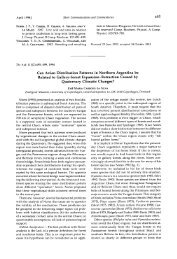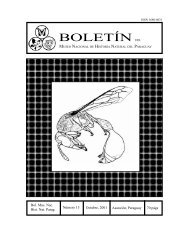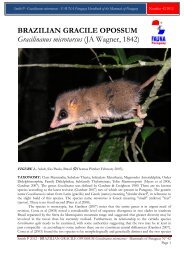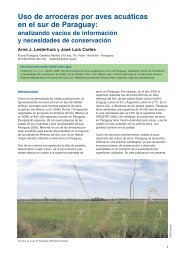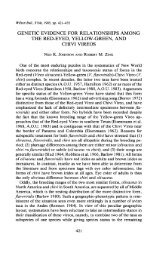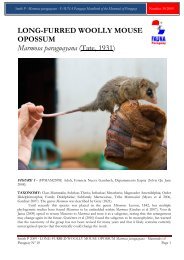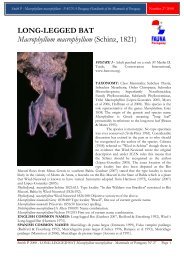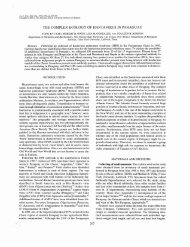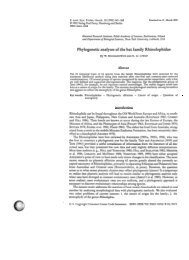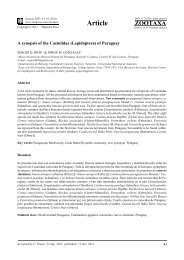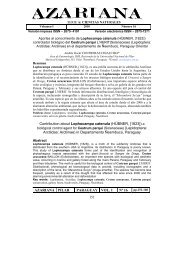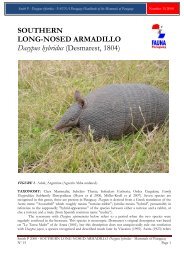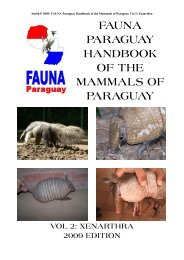CHACO FAIRY ARMADILLO Calyptophractus ... - FAUNA Paraguay
CHACO FAIRY ARMADILLO Calyptophractus ... - FAUNA Paraguay
CHACO FAIRY ARMADILLO Calyptophractus ... - FAUNA Paraguay
Create successful ePaper yourself
Turn your PDF publications into a flip-book with our unique Google optimized e-Paper software.
Smith P - <strong>Calyptophractus</strong> retusus - <strong>FAUNA</strong> <strong>Paraguay</strong> Handbook of the Mammals of <strong>Paraguay</strong> Number 20 2008<br />
CONSERVATION STATUS: Globally considered Data Deficient by the IUCN (Abba & Superina<br />
2010), see http://www.iucnredlist.org/search/details.php/4703/all for the latest assessment of the<br />
species. The Centro de Datos de Conservación in <strong>Paraguay</strong> consider the species to be endangered in<br />
<strong>Paraguay</strong> and give it the code N2. Though little is known of its biology it is clearly locally distributed and a<br />
population decline in the range of 10-25% in the last 10 years is not unthinkable (Abba & Superina 2010).<br />
Merritt (2008) did not encounter the species in the Central Chaco area during more than 20 years of<br />
periodic fieldwork.<br />
This is a Chaco endemic species and though widespread in Bolivia and <strong>Paraguay</strong> it is locally<br />
distributed and occurs only in areas with loose sandy soils. It may also occur in sandy soil areas of the<br />
Pantanal in <strong>Paraguay</strong> and Brazil, though to date it has not been recorded there. Considered an animal of<br />
ill-omen, it is killed by humans when encountered and such pressure on a rare species is likely to have<br />
telling effects on the population. Though it thrives in secondary habitats it would seem that the population<br />
is in decline, though no data is available to support the assumption. Conversion of appropriate habitat to<br />
pasture may affect the species but fortunately in <strong>Paraguay</strong> much of the range of the species is at least<br />
nominally protected in the various national parks of the Chaco region. However it should be noted that<br />
these parks are protected more by their isolation than by an effective conservation plan. (Edentate<br />
Specialist Group 2004).<br />
REFERENCES:<br />
Abba AM, Superina M 2010 - The 2009/2010 Armadillo Red List Assessment - Edentata 11: p135-184.<br />
Anderson A 1997 - Mammals of Bolivia: Taxonomy and Distribution - Bulletin AMNH 231: p1-652.<br />
Azurduy H, Aguanta F, Acosta L 2005 - Nota Sobre los Regístros y Distribución de Chlamyphorus retusus<br />
en Bolivia - Kempffiana 1: p58-62.<br />
Burmeister H 1863 - Ein Neuer Chlampyphorus - Abhandl. Naturfors. Gesell. Halle 7: p165-171.<br />
Cuéllar E 2001 - The Tatujeikurajoyava (Chlamyphorus retusus) in the Izozog Communities of the Bolivian<br />
Gran Chaco - Edentata 4: p14-15.<br />
Cuéllar E, Noss A 2003 - Mamíferos del Chaco y de la Chiquitania de Santa Cruz, Bolivia - Editorial<br />
FAN, Santa Cruz.<br />
Edentate Specialist Group 2004 - Species Summaries - Edentata 6: p3-26.<br />
Fitzinger LJ 1871 - Die Natürliche Familie der Gürtheliere (Dasypodes) I Abtheilung - Sitzungsber. Kaiserl.<br />
Akad. Wiss. Wien 64:p209-276.<br />
Gardner AL 2007 - Mammals of South America Volume 1: Marsupials, Xenarthrans, Shrews and Bats -<br />
University of Chicago Press.<br />
Gray JE 1865 - Revision of the Genera and Species of Entomophagous Edentata, Founded on the<br />
Examination of the Specimens in the British Museum - Proceedings of Zoological Society of London 1865: p359-<br />
386.<br />
Guglielmone AA, Estrada-Peña A, Luciani CA, Mangold AJ, Keirans JE 2003 - Hosts and<br />
Distribution of Amblyomma auricularium (Conil 1878) and Amblyomma pseudoconcolor Argaão, 1908 (Acari:<br />
Ixodidae) - Experimental and Applied Acarolgy 29: p131-139.<br />
Merritt D 2008 - Xenarthrans of the <strong>Paraguay</strong>an Chaco p294-299 in Vizcaino SF, Loughry WJ The Biology<br />
of the Xenarthra - University Press of Florida.<br />
Möller-Krull M, Delsuc F, Churakov G, Marker C, Superina M, Brosius J, Douzery EJP, Schmitz J<br />
2007 - Retroposed Elements and Their Flanking Regions Resolve the Evolutionary History of Xenarthran<br />
Mammals (Armadillos, Anteaters and Sloths) - Molecular Biology and Evolution 24: p2573-2582.<br />
Myers P, Espinosa R, Parr CS, Jones T, Hammond GS, Dewey A 2006 - The Animal Diversity Web<br />
(online). Accessed December 2007.<br />
Neris N, Colman F, Ovelar E, Sukigara N, Ishii N 2002 - Guía de Mamíferos Medianos y Grandes<br />
del <strong>Paraguay</strong>: Distribución, Tendencia Poblacional y Utilización - SEAM, Asunción.<br />
Nowak RM 1991 - Walker´s Mammals of the World 5th Ed Volume 1 - Johns Hopkins, Baltimore.<br />
Redford KH, Eisenberg JF 1992 - Mammals of the Neotropics: Volume 2 The Southern Cone -<br />
University of Chigaco Press, Chicago.<br />
Vizcaíno SF, Milne N 2002 - Structure and Function in Armadillo Limbs (Mammalia: Xenarthran:<br />
Dasypodidae) - Journal of Zoological Society of London 257: p117-127.<br />
Smith P 2008 - <strong>CHACO</strong> <strong>FAIRY</strong> <strong>ARMADILLO</strong> <strong>Calyptophractus</strong> retusus - Mammals of <strong>Paraguay</strong> Nº 20<br />
Page 4



